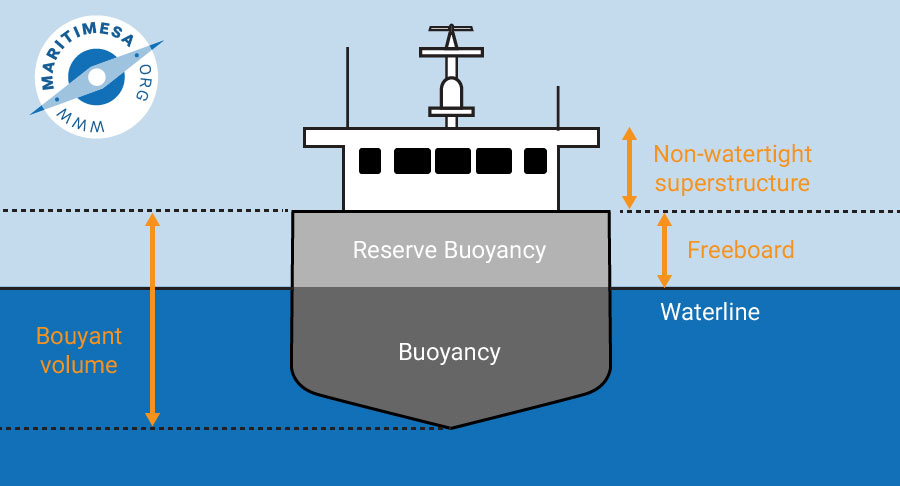The following concepts and definitions apply to the stability of vessels at sea:
-
- Tonnage deck. This is the upper deck in single deck ships and the deck next below the upper deck in other ships.
- Tonnage. This is the enclosed/internal capacity (volume) of a ship measured in tons, i.e. the internal volume of a ship expressed in tons. (One ton is equal to 2.83 cubic metres).
- Gross Tonnage. This is the internal volume of a ship below the tonnage deck plus the ‘tween deck tonnage which includes the volume of any closed-in spaces on or above the tonnage deck.
- Net or Register Tonnage. This is the earning capacity of a merchant ship, ie the gross tonnage minus the volumes of non-earning spaces such as the engine room, the bridge, workshops, store rooms, accommodation, etc.
- Deadweight Tonnage. This is the total weight of the cargo, stores, fuel, fresh water and crew which a vessel can carry when loaded down to her marks, and it is measured in tonnes weight. (One tonne is equal to 1000 kilograms).
- Archimedes’ Law. Archimedes’ law states that a floating object will displace the same volume of the liquid in which it floats as that of the object projecting below the level of the liquid. Stated in other terms, a floating object will displace the same mass or weight of the liquid in which it floats as the mass or weight of the object itself.
- Displacement. This is the actual weight of a vessel measured in tonnes weight, ie it is the amount of water she displaces when floating.

Floatation and displacement.
- Buoyant Volume. This is the volume of the entire watertight part of the hull.

Buoyant volume.
- Buoyancy. This is the portion of the buoyant volume below the waterline.
- Reserve Buoyancy. This the portion of the buoyant volume which is above the waterline.
- Centre of Gravity. This is the central point through which the downward force exerted by the weight of the ship and everything in it, works. In a stability diagram it is denoted by the letter “G”.
- Centre of Buoyancy. This is the central point through which the upward force exerted by the water in which the vessel floats, works. It is usually denoted by the letter “B” in a stability diagram, It is the geometric centre of the underwater volume.

Centre of buoyancy.
- Righting Lever. This is the horizontal distance GZ, which separates the forces of weight and volume as the ship heels.

Righting lever.
- Metacentre. This is the point through which the lines of upthrust through the initial (B), and slightly inclined (B1), centres of buoyancy cut. It is usually denoted by the letter “M”.
- Heel. This is the vessel’s athwartship inclination either side of the vertical, no matter how it was caused.
- List. This is a heel caused by off-centre loading, ie G is not on the centreline.
- Trim. This is the inclination of the ship’s designed horizontal fore and aft plane with the surface of the water in which she floats. When in normal trim this plane lies parallel with the surface of the water.

Vessel’s fore and aft trim.
- Loll. Loll describes an unstable state of the vessel when in an upright position. It therefore floats at an angle of heel to one side or the other. If disturbed by an outside force, ie the wind or waves, the ship will lurch to the same angle of loll on the opposite side. Loll is caused by a large free surface of liquid inside the hull or by the addition of too much top weight.


